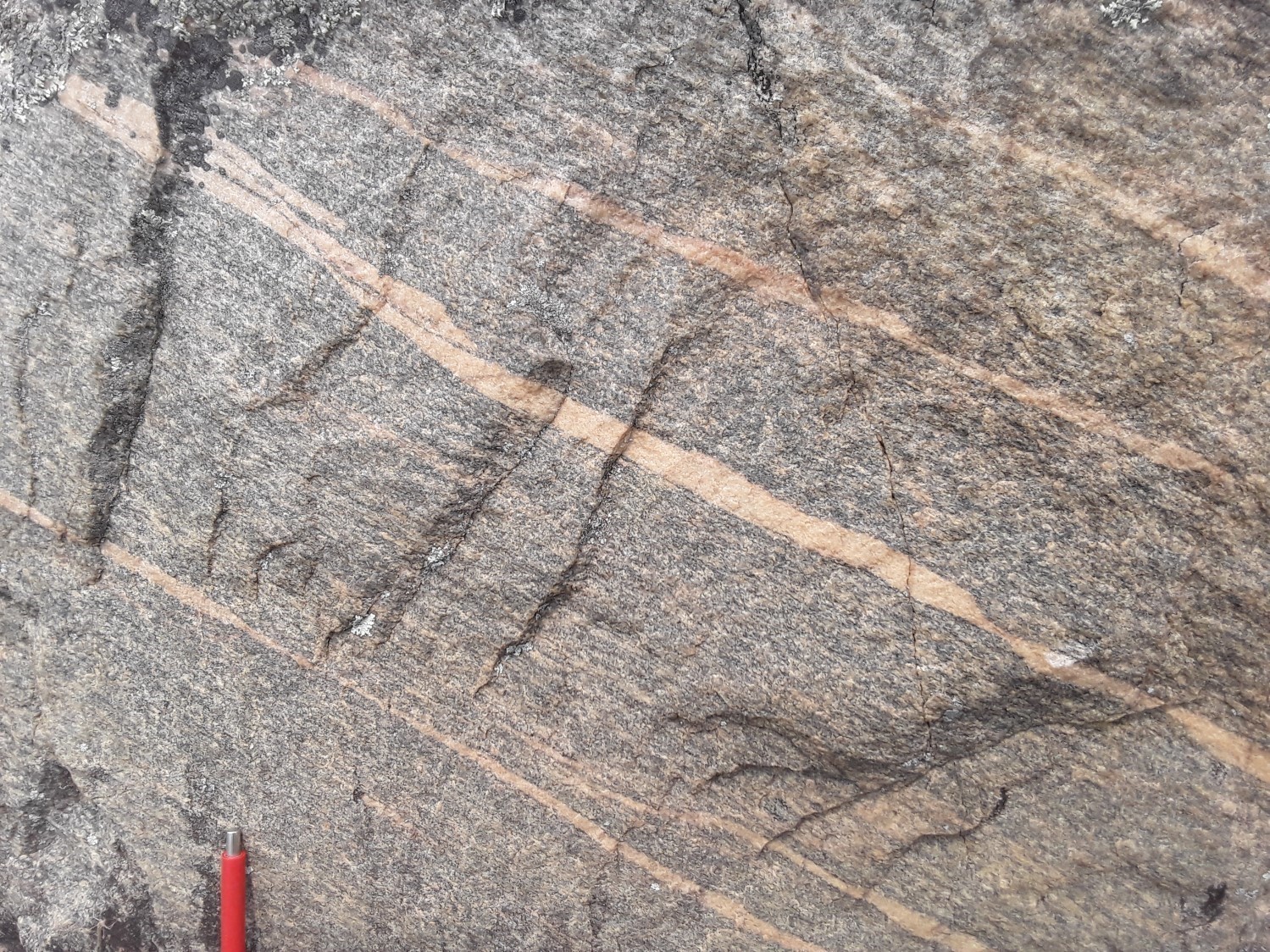
DISCLAIMER: This English version is translated from the original French. In case of any discrepancy, the French version shall prevail.
| Author(s): | Bilodeau, 2022 |
| Age: | Mesoproterozoic |
| Stratotype: | Reference outcrop 2021-CB-1223 |
| Type area: | Along the Outaouais River, in the Île du Rocher-Fendu area (NTS sheet 31F10) |
| Geological province: | Grenville Province |
| Geological subdivision: | Allochton |
| Lithology: | Intermediate to felsic intrusive rocks |
| Category: | Lithodemic |
| Rank: | Suite |
| Status: | Formal |
| Use: | Active |
Background
The Rocher-Fendu Intrusive Suite was introduced by Bilodeau (2022) after a geological survey carried out in the Île-du-Grand-Calumet area in 2021. The unit was first defined in Ontario by Lumbers (1980) on the west side of the Outaouais River, describing felsic to intermediate gneissic biotite rocks, and minor amounts of trondhjemite and tonalite, cut by pegmatite dykes.
Description
The Rocher-Fendu Intrusive Suite (mPrfd) is composed of intermediate to felsic rocks in two scattered subunits, which correspond to two intrusions of different compositions and geochemical affinities. The first subunit, mPrfd1, corresponds to a polyphase calc-alkaline to alkaline intrusion occurring in the Île du Rocher-Fendu area, along the Outaouais River, between the villages of Portage-du-Fort and Bryson. The alkaline intrusion of the second subunit, mPrfd2, outcrops in the Île Lafontaine area, in the central-western part of Île du Grand-Calumet.
Rocher-Fendu Intrusive Suite 1 (mPrfd1): Diorite, leucocratic granodiorite, leuconorite
The mPrfd1 subunit is made up of equivalent amounts of two main lithological facies, determined on the basis of their differences in composition and geochemical affinity: 1) calc-alkaline diorite, and 2) calc-alkaline to alkaline granodiorite. A calc-alkaline leuconorite facies was also observed in at least two outcrops. All three facies contain enclaves 10 cm in diameter of various compositions, including amphibolite, gabbro and calc-silicate rocks. Outcrops in this subunit are also characterized by the presence of 5% to 10% centimetric bands of pink felsic rocks that run parallel to the foliation.
Dioritic Facies

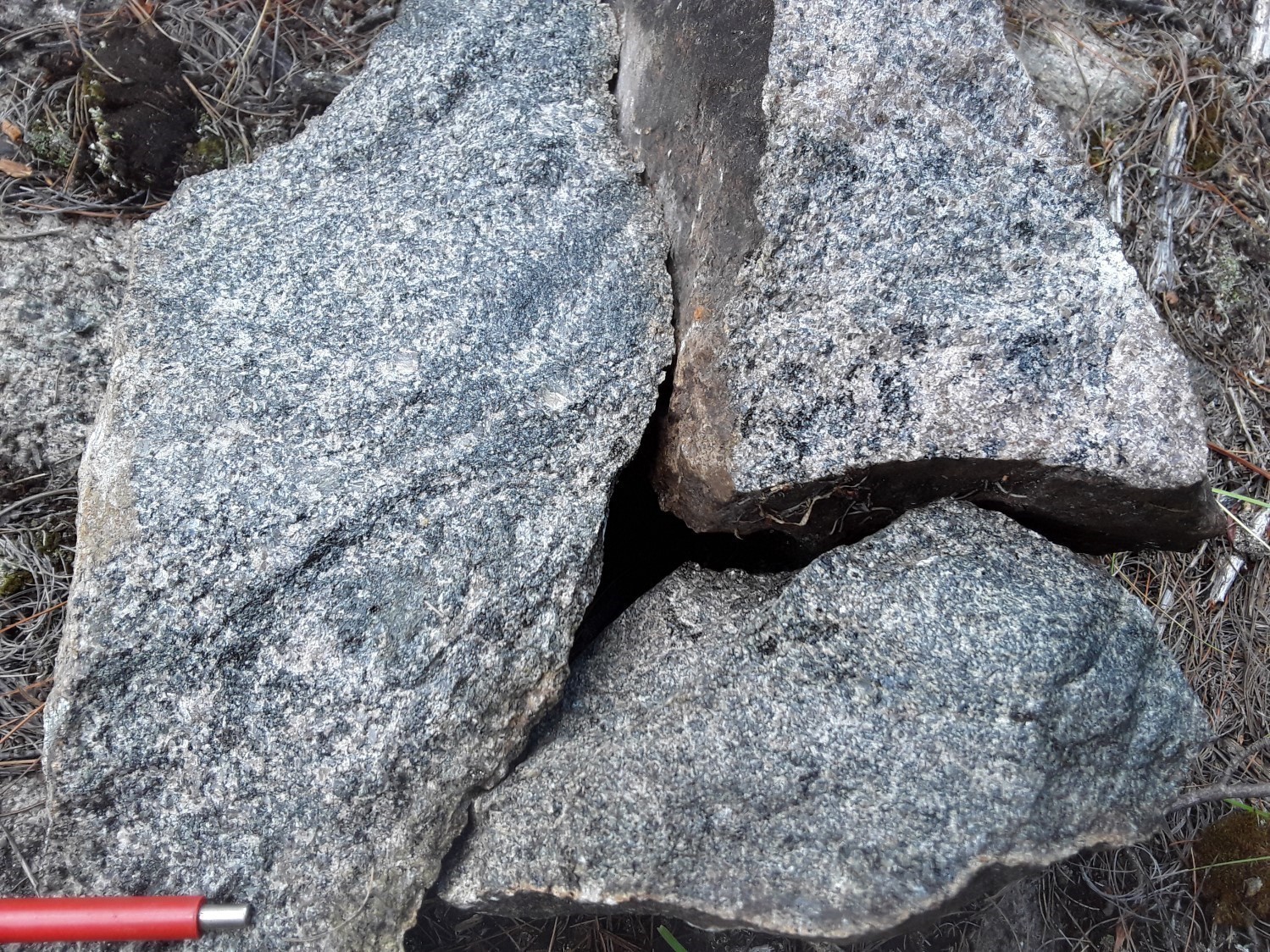
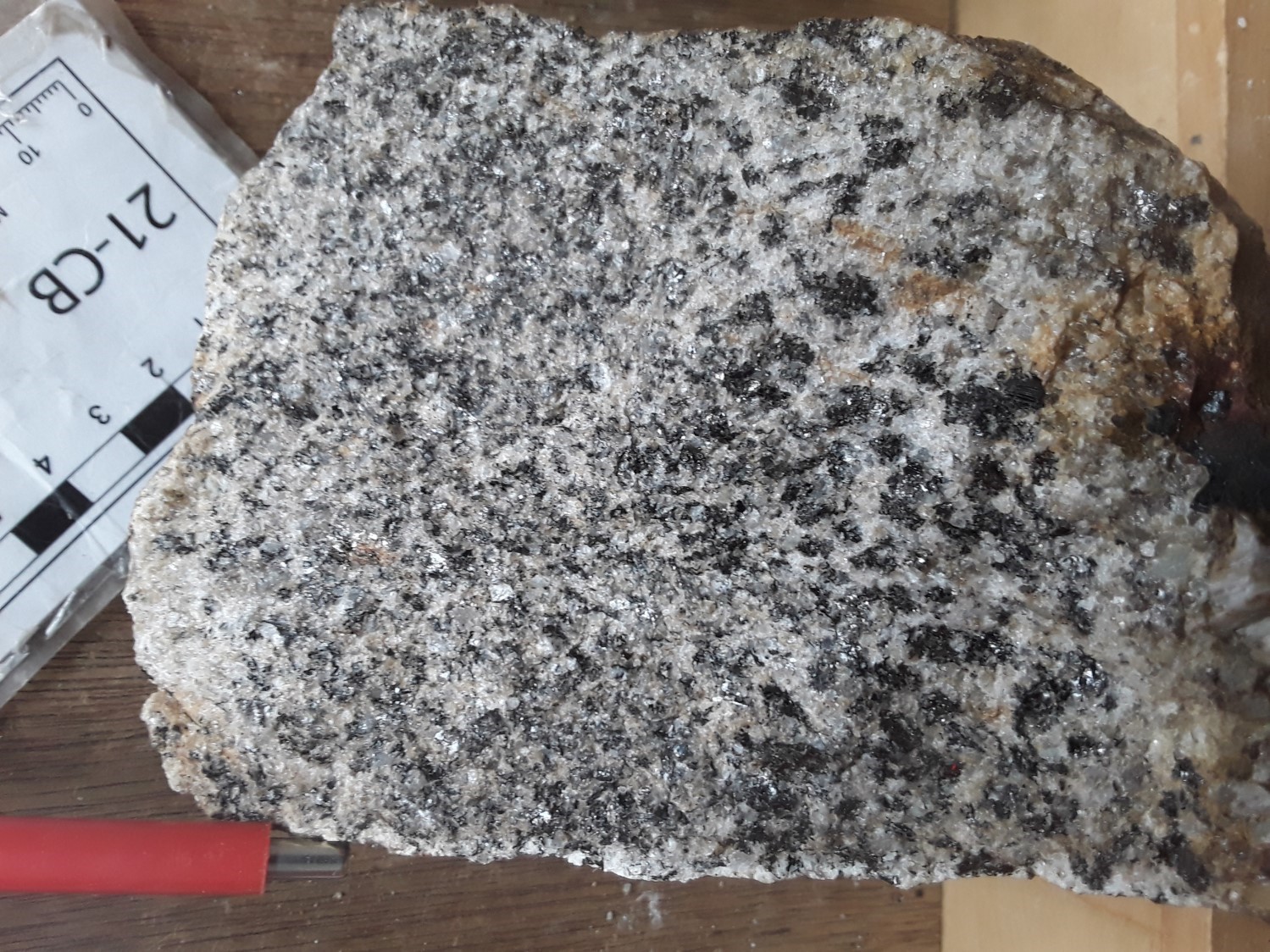
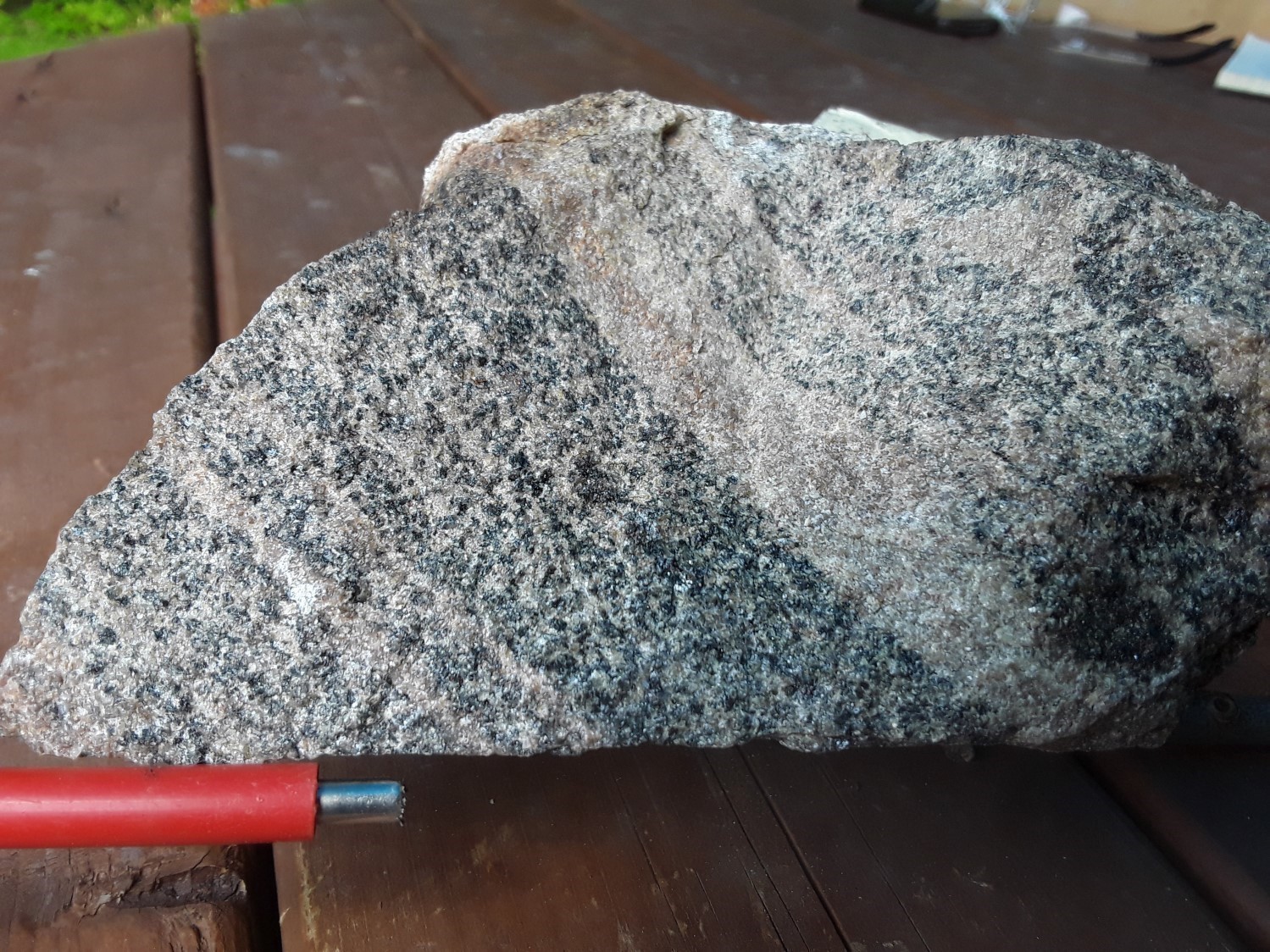 The dioritic facies is locally heterogeneous in grain size and composition. The rocks are fairly dark, varying from beige to brownish in altered patina and beige-grey, brown or greenish-grey in fresh surface. The diorite is generally fine to coarse grained; locally, there are zones containing small millimetre-sized hornblende phenocrysts. The rock is composed of varying amounts of feldspar, ferromagnesian minerals and smoky quartz, contributing to its dark colour. K-feldspar varies from 10% to 20%; it occurs as orthoclase in medium-sized isolated crystals and in clusters of small microcline crystals. Hornblende forms fine to medium-sized unaltered crystals that are homogeneously distributed within the rock. Biotite is generally found in medium-sized laths that define a faint foliation. The dioritic facies has a strong magnetic susceptibility.
The dioritic facies is locally heterogeneous in grain size and composition. The rocks are fairly dark, varying from beige to brownish in altered patina and beige-grey, brown or greenish-grey in fresh surface. The diorite is generally fine to coarse grained; locally, there are zones containing small millimetre-sized hornblende phenocrysts. The rock is composed of varying amounts of feldspar, ferromagnesian minerals and smoky quartz, contributing to its dark colour. K-feldspar varies from 10% to 20%; it occurs as orthoclase in medium-sized isolated crystals and in clusters of small microcline crystals. Hornblende forms fine to medium-sized unaltered crystals that are homogeneously distributed within the rock. Biotite is generally found in medium-sized laths that define a faint foliation. The dioritic facies has a strong magnetic susceptibility.
Granodioritic Facies
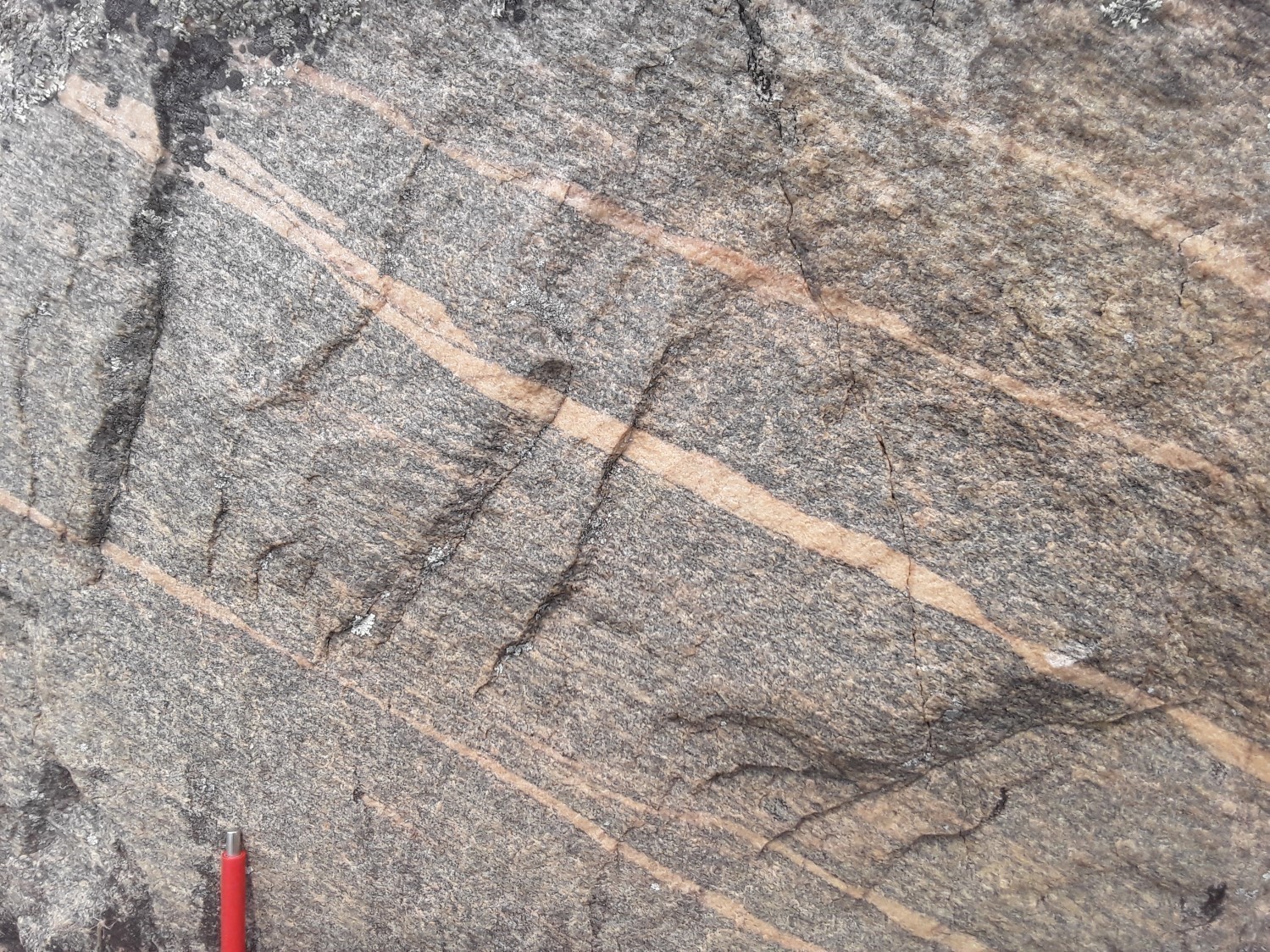

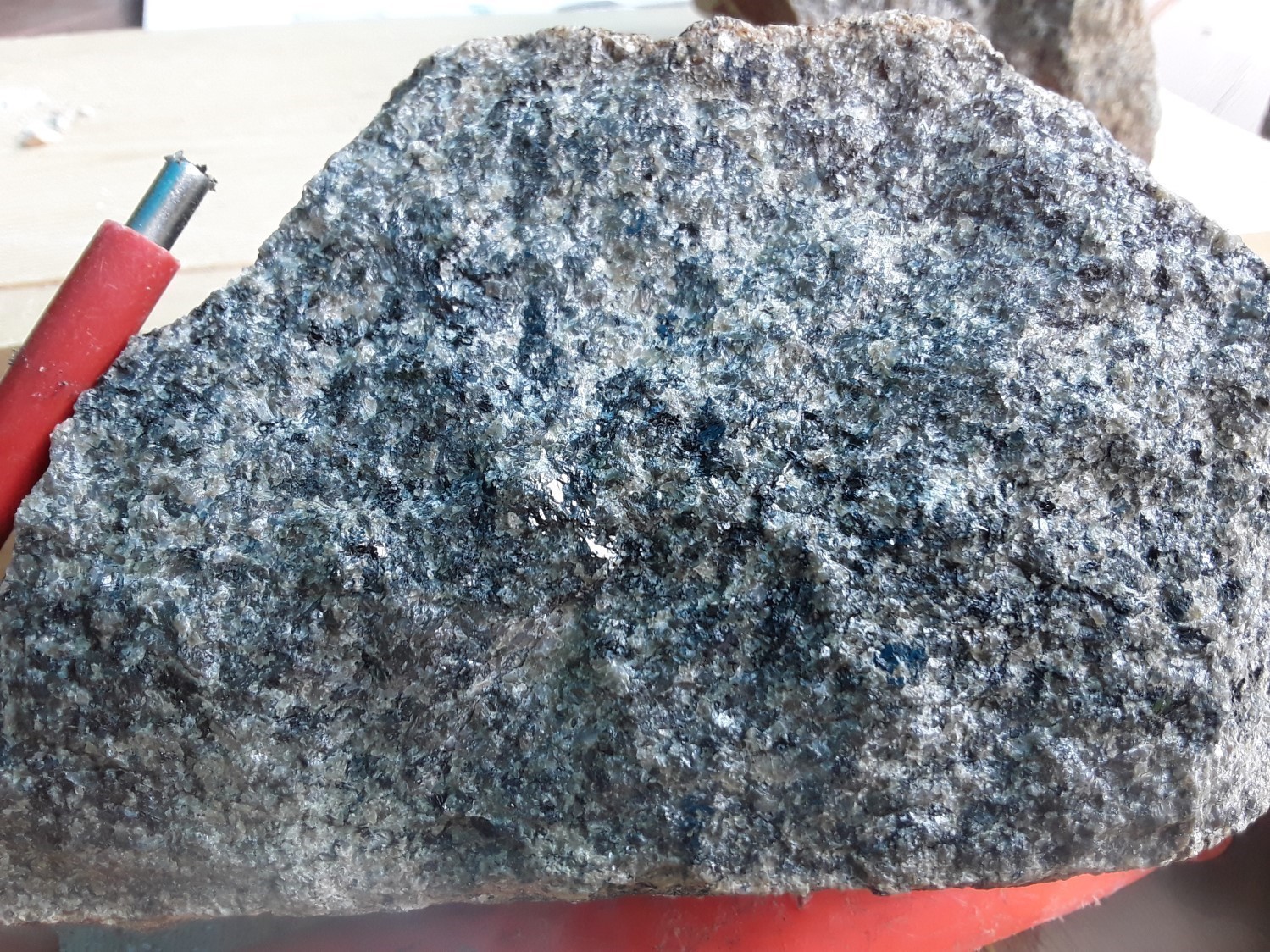 The granodiorite is generally leucocratic, with a light-grey alteration patina that distinguishes it from the darker granodiorite. In places, it displays a white weathering crust. The fresh surface is dark grey to dark greenish-grey and locally pink with a vitreous lustre. The granodiorite is fine to medium grained and composed of 60% to 70% very weakly damouritized plagioclase, a variable amount of quartz representing ~20% of the volume of the rock and medium-sized K-feldspar (orthoclase) constituting ~10% of the rock. The amount of ferromagnesian minerals is also variable, being absent in some samples. Biotite dominates (up to 7%), followed by hornblende (3%). There are also numerous centimetric quartzofeldspathic clusters, highlighted by the accumulation of biotite crystals around their edges.
The granodiorite is generally leucocratic, with a light-grey alteration patina that distinguishes it from the darker granodiorite. In places, it displays a white weathering crust. The fresh surface is dark grey to dark greenish-grey and locally pink with a vitreous lustre. The granodiorite is fine to medium grained and composed of 60% to 70% very weakly damouritized plagioclase, a variable amount of quartz representing ~20% of the volume of the rock and medium-sized K-feldspar (orthoclase) constituting ~10% of the rock. The amount of ferromagnesian minerals is also variable, being absent in some samples. Biotite dominates (up to 7%), followed by hornblende (3%). There are also numerous centimetric quartzofeldspathic clusters, highlighted by the accumulation of biotite crystals around their edges.
Leuconoritic Facies
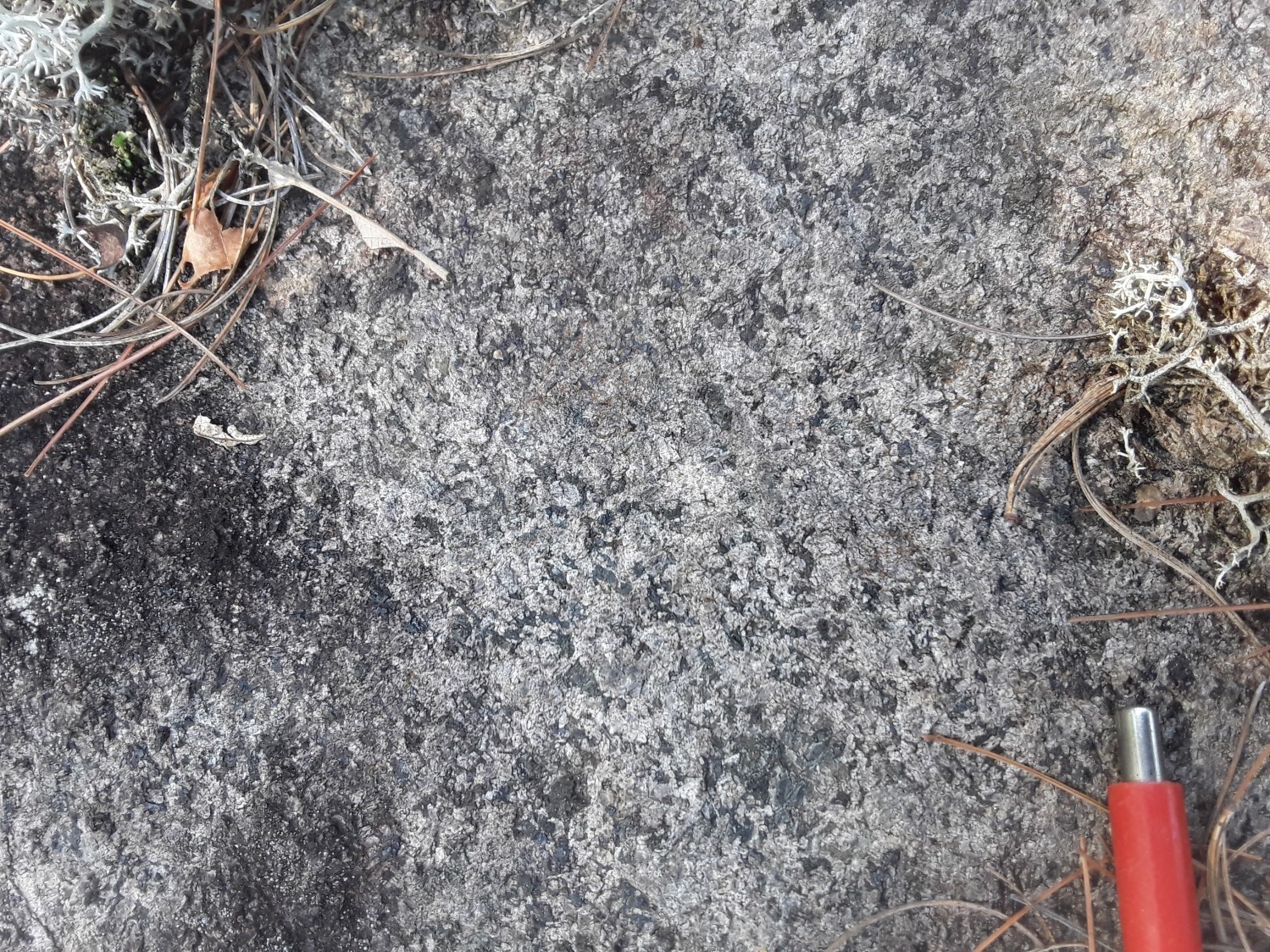
 Leuconorite has a calc-alkaline geochemical affinity. It is observed in at least two outcrops (e.g. outcrop 2021-CB-1227). The rock is grey to dark grey in fresh surface and light grey speckled with brown earthy minerals in negative relief in weathered surface. The rock locally displays a millimetre-thick brown alteration crust. Typical samples are composed of 65% to 70% medium to coarse crystals of plagioclase, generally euhedral and without preferential orientation. To a lesser extent, plagioclase forms clusters of rounded crystals forming triple junctions under the microscope, indicating recrystallization. Samples contain up to 25% medium orthopyroxene crystals interstitial to plagioclase laths and 2% to 5% clinopyroxene. Pyroxene crystals are partially uralitized, but their cores are mostly preserved. Other ferromagnesian minerals include hornblende in fine isolated crystals and 2% to 3% biotite associated with pyroxene, hornblende and opaque minerals.
Leuconorite has a calc-alkaline geochemical affinity. It is observed in at least two outcrops (e.g. outcrop 2021-CB-1227). The rock is grey to dark grey in fresh surface and light grey speckled with brown earthy minerals in negative relief in weathered surface. The rock locally displays a millimetre-thick brown alteration crust. Typical samples are composed of 65% to 70% medium to coarse crystals of plagioclase, generally euhedral and without preferential orientation. To a lesser extent, plagioclase forms clusters of rounded crystals forming triple junctions under the microscope, indicating recrystallization. Samples contain up to 25% medium orthopyroxene crystals interstitial to plagioclase laths and 2% to 5% clinopyroxene. Pyroxene crystals are partially uralitized, but their cores are mostly preserved. Other ferromagnesian minerals include hornblende in fine isolated crystals and 2% to 3% biotite associated with pyroxene, hornblende and opaque minerals.
Rocher-Fendu Intrusive Suite 2 (mPrfd2): Homogeneous quartz monzodiorite
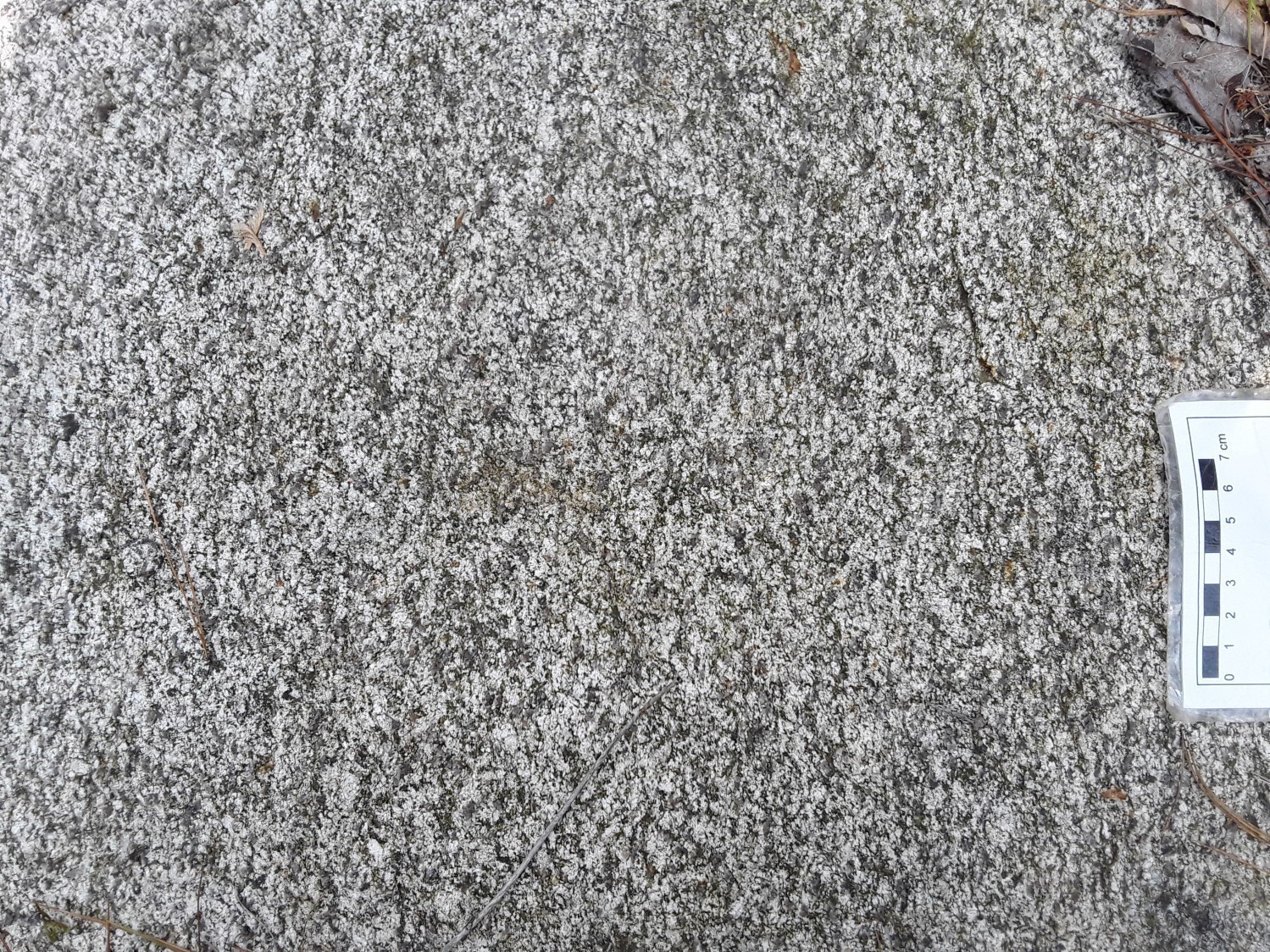
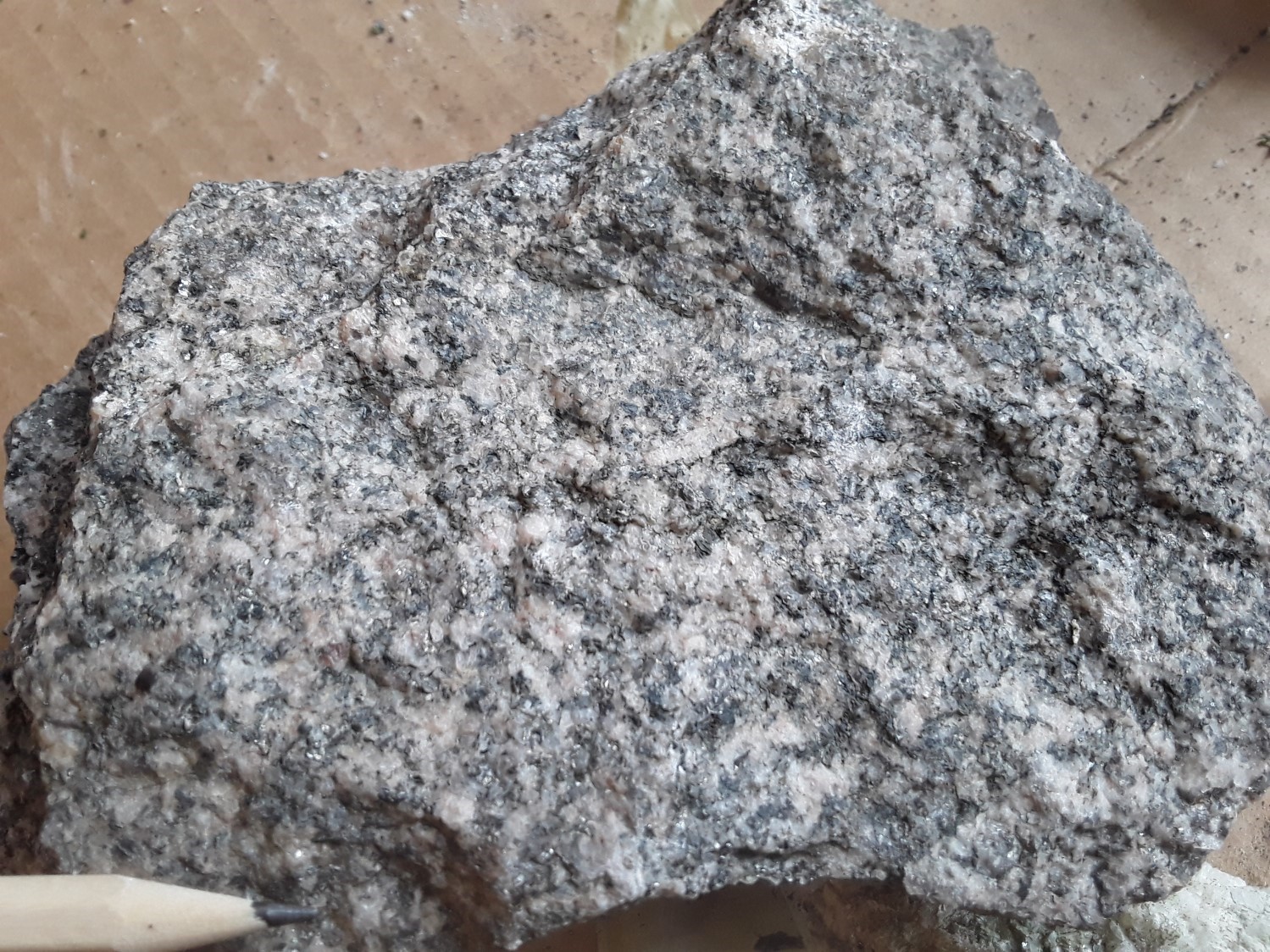 The mPrfd2 subunit is composed of homogeneous quartz monzodiorite and, locally, quartz diorite of calc-alkaline to alkaline geochemical affinity. The rocks have a pinkish-beige to light grey alteration patina and are generally grey in fresh surface, with a slight pinkish tinge in some outcrops. Microscopically, the subunit is composed of slightly saussuritized, stocky plagioclase and 5% to 10% heterogranular quartz in isolated crystals. The rock is composed on average of 10% fine to medium-sized biotite and 5% to 10% hornblende. The distribution of hornblende and biotite is generally uniform, with the exception of localized diffuse clusters containing higher concentrations of biotite. The rock contains 2% to 8% K-feldspar (orthoclase) heterogeneously distributed, and accessory minerals include epidote, titanite, monazite, zircon and opaque minerals. The rocks are fairly homogeneous and display very little structural or compositional variation, as the minerals are neither deformed nor recrystallized.
The mPrfd2 subunit is composed of homogeneous quartz monzodiorite and, locally, quartz diorite of calc-alkaline to alkaline geochemical affinity. The rocks have a pinkish-beige to light grey alteration patina and are generally grey in fresh surface, with a slight pinkish tinge in some outcrops. Microscopically, the subunit is composed of slightly saussuritized, stocky plagioclase and 5% to 10% heterogranular quartz in isolated crystals. The rock is composed on average of 10% fine to medium-sized biotite and 5% to 10% hornblende. The distribution of hornblende and biotite is generally uniform, with the exception of localized diffuse clusters containing higher concentrations of biotite. The rock contains 2% to 8% K-feldspar (orthoclase) heterogeneously distributed, and accessory minerals include epidote, titanite, monazite, zircon and opaque minerals. The rocks are fairly homogeneous and display very little structural or compositional variation, as the minerals are neither deformed nor recrystallized.
Thickness and distribution
The Rocher-Fendu Intrusive Suite is subdivided into two distinct intrusions (mPrfd1 and mPrfd2). Their respective surface areas are estimated at ~20 km² each, based on their extensions in Ontario, according to the mapping work of Lumbers (1980).
Dating
Zircons from a sample of quartz monzodiorite in unit mPrfd2 (outcrop 2021-CB-1155) were analyzed for dating by LA-ICP-MS and returned an age of 1195 ±7 Ma (Davis, 2023). This result is interpreted as the crystallization age of the intrusion, making it the youngest known intrusive unit in the area. Analysis of monazites from the same sample yielded an age of 1042 ±19 Ma. This result is interpreted as the approximative age of regional metamorphism associated with the Ottawa phase of the Grenvillian orogeny (Rivers, 1989).
| Unit | Sample Number | Isotopic System | Mineral | Crystallization Age (Ma) | (+) | (-) | Metamorphic Age (Ma) | (+) | (-) | Reference(s) |
| mPrfd2 | 2021-CB-1155A | U-Pb | Zircon | 1195 | 7 | 7 |
Davis, 2023 |
|||
| Monazite | 1042 | 19 | 19 |
Stratigraphic Relationship(s)
The Rocher-Fendu Intrusive Suite comprises two intrusions, only one of which provides geochronological data revealing the youngest plutonic age in the area. By extrapolation, this data indicates that the unit chronologically cuts all the others. Metasedimentary rocks of the Outaouais Supracrustal Sequence have been observed to crosscut each other, particularly in the Dingo Traverse area, north of the municipality of Portage-du-Fort. There is an abundance of enclaves of all compositions, including mafic rocks possibly associated with the Grand-Calumet Complex, and calc-silicate rocks interpreted as originating from the Outaouais Supracrustal Sequence.
Paleontology
Does not apply.
References
Publications available through SIGÉOM Examine
BILODEAU, C., 2022. Géologie de la région de l’Île-du-Grand-Calumet, Province de Grenville, Outaouais, Québec, Canada. MERN; BG 2022-07, 1 plan.
DAVIS, D.W., 2023. Rapport sur les datations U-Pb de roches du Québec 2021-2022. MRNF; MB 2023-02
Other publications
LUMBERS, S.B., 1980. Pembroke Area Eastern Part Southern Ontario. Ontario Geological Survey; Preliminary Map P.2356, scale 1:63 360 or 1 inch to 1 mile.
RIVERS, T., MARTIGNOLE, J., GOWER, C.F., DAVIDSON, A., 1989. New tectonic divisions of the Grenville Province, southest Canadian Shield. Tectonics; volume 8, pages 63-84. doi.org/10.1029/TC008i001p00063
Suggested Citation
Ministère des Ressources naturelles et des Forêts (MRNF). Rocher-Fendu Intrusive Suite. Quebec Stratigraphic Lexicon. https://gq.mines.gouv.qc.ca/lexique-stratigraphique/province-de-grenville/suite-intrusive-de-rocher-fendu_en/ [accessed on Day Month Year].
Contributors
|
First publication |
Carl Bilodeau, P.Geo., M.Sc. carl.bilodeau@mern.gouv.qc.ca (redaction) Céline Dupuis, P.Geo., Ph.D. (coordination); Abdelali Moukhsil, P.Geo., Ph.D. (critical review); Simon Auclair, P.Geo., M.Sc. (editing); Catherine Tremblay (English version); André Tremblay (HTML editing). |

